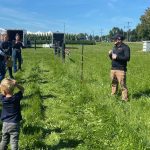When a Manitoba farmer pleaded guilty three years ago to endangering his five-year-old son who was driving a truck on a public road, many parents gasped.
Some were shocked that a young child would be given such a task. Others realized they should stop putting their own young farmers into such situations.
Parents who have wondered how much work they can put on their children’s shoulders now have guidelines to help in the decision. The guidelines released June 21 were developed over the past three years, with mainly American funding, by a committee of 10 farm safety specialists in North America.
Read Also

Agri-business and farms front and centre for Alberta’s Open Farm Days
Open Farm Days continues to enjoy success in its 14th year running, as Alberta farms and agri-businesses were showcased to increase awareness on how food gets to the dinner plate.
“Most parents are searching for answers as to how they can reduce the risk of injury or death to their children. A little time spent evaluating children before assigning tasks may end up saving their lives,” said Bruce Johnston, one of the three Canadian representatives on the committee. He manages the Farm and Ranch Safety and Health Association in British Columbia.
The 62 guidelines were developed because statistics show not only is farming the most hazardous occupation in Canada and the United States, but one in five farm deaths is a child under age 16. Half of those childhood fatalities result from being run over by farm machinery.
“Farm parents need to be good role models for their children by teaching them that the safe way is the only way,” Johnston said in a news release.
The North American Guidelines for Children’s Agricultural Tasks help parents assess their child’s mental and physical readiness to safely complete common farm chores. The guidelines for children aged seven to 16 cover animal care, manual labor, haying, operating implements, specialty production, tractor fundamentals and general activities.
Each guideline shows an illustration of the task, a list of adult responsibilities, a checklist to assess a child’s abilities to do the work, the steps necessary to do the task safely, the hazards of the chore and the type of supervision recommended.
Another Canadian who helped develop the guidelines, Glen Blahey of Manitoba Agriculture, said the list is intended to advise, not regulate through government.
He said the age that children start driving machinery varies from family to family.
“I know of some who don’t do it independently until 15 or 16. They do it under supervision. But some have young 10-year-olds driving.”
Children not all the same
Surveys show parents assign chores based primarily on intuition about their child’s capabilities and the age the parent was when he or she first performed a task.
Blahey said the guidelines are not intended to replace day care for younger children.
“Their intention is for the person in charge to make an informed decision about the appropriateness of the task for a child.”
Blahey said children have to not only have the physical size but also the psychological perspective to do a complicated task. Is the child capable of remembering and repeating four or five steps? Machinery requires the operator to co-ordinate several skills at once.
Teenagers think they are immortal so may take risks they shouldn’t, he said. Also, they are still growing and feet and hands that they were comfortable with can suddenly become clumsy after a growth spurt.
Blahey said he doesn’t think there are more children doing farm tasks than before, even though one parent is often working off the farm and unavailable to do chores.
“My sense is that things are fairly constant. Kids always move into a slow apprenticeship of farming. You can see it in the farm injuries that show boys are injured on machinery and girls with animals.”
For more information parents can phone 800-382-8473 or check the website www.nagcat.com.














